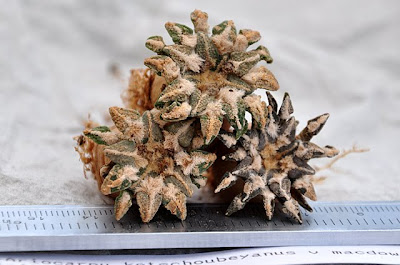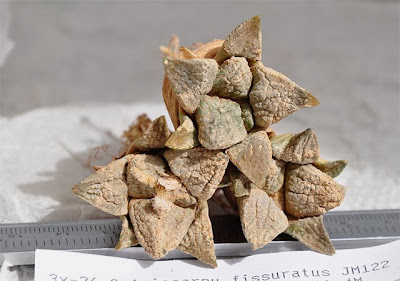I'm not a seasoned Ariocarpus grower but still in a slow but steady process of building a collection of these magnificent plants. I'm learning to handle the deep levels of patience required to grow Ariocarpus from seed, but sometimes I give in to my eagerness and have to buy a few plants ;-)
Ariocarpus kotschoubeyanus v. macdowellii
I like Mesa Garden's hard grown plants that almost invariably come with locality information. As I live in Denmark and Mesa Garden is located in New Mexico it is quite cumbersome and expensive to import plants (I once contacted the Danish plant directorate to get directions on importing cacti from countries outside of the European Union and was told it would involve import permits, CITES and phytosanitary documents plus an inspection of the plants upon arrival). To work around these obstacles I order plants whenever in the US and have them shipped to my hotel; from there they travel to Denmark packed in my suit case.
Ariocarpus kotschoubeyanus v. macdowellii, side view
I have only praise for the service offered by Mesa Garden, they are always responsive and extremely helpful in arranging timely deliveries - even within very short windows of time. Remember to specify substitutes, though. 
Ariocarpus fissuratus
I spent part of my summer vacation in New York City and again took the opportunity to order plants and seeds from Mesa Garden. Apart from the Ariocarpus kotschoubeyanus var. macdowellii (SB 100; El Pilar, Coahuila) and A. fissuratus (JM 122; Fort Stockton, Texas) featured in this post, I also ordered some Ariocarpus intermedius and A. retusus. Unfortunately Steven was out of the varieties I ordered of the latter two species, and I forgot to specify substitutes and consequently received only half of the plants that I ordered. Disappointing as it may be not to receive all the plants you are eagerly expecting, this is the only approach that makes sense (especially when you are focusing on the finer details like locality information) - I for sure would have been disgruntled to receive random substitutes as I was going specifically for the more cold hardy varieties of Ariocarpus as these plants will be growing in my cold house. I'll remember to specify substitutes with my next order ;-) 
Ariocarpus fissuratus, side view
As usual the plants received from Mesa Garden are compact and healthy. The Ariocarpus kotschoubeyanus var. macdowellii (SB 100; El Pilar, Coahuila) plants are approximately 4 cm high and 2.5 cm wide while the A. fissuratus (JM 122; Fort Stockton, Texas) plants are 4.5 cm high (excluding the fine roots) and 3.5 cm wide.
The plants were potted in the soil mix described in a recent post. The photo below illustrates quite well that these plants are so “cryptic” that you can walk right past them or trample them underfoot in the wild without noticing it, especially the A. fissuratus plants are extremely well camouflaged in this case.
Newly potted Ariocarpus plants
Lately I have been taken by Echinocactus and thus also ordered 100 seeds each of Echinocactus horizonthalonius (SB 409; Shafter, Texas), E. polycephalus (SNL 91; Las Vegas, Nevada), and E. texensis (SB 2006; Roosevelt Co, New Mexico) - E. texensis is also known as Homalocephala texensis. I'm completely new to raising Echinocactus from seed and decided to do a test run a couple of months ago, using only a few of the seeds (as it was very late in the season for seed starting). I scarified the seeds by rubbing them against a whetstone and soaked them in water for 24 hours. Today 25% of the E. texensis and 10% of the E. horizonthalonius have germinated while the E. polycephalus seeds still show no signs of activity. I know that the seeds probably need more heat and light than I can supply at this time of year, in order to germinate properly.
If you have more advice on starting Echinocactus from seed (especially the above mentioned species ;-) I would love to learn about it.
Wednesday, October 14, 2009
A few Ariocarpus plants and a handful of Echinocactus seeds from Mesa Garden
The Lophophora Blog is on Facebook
 Just to let you know that I have set up a profile for the Lophophora Blog on Facebook along with a couple of pages. One of the pages more or less heralds all of the posts from this blog while the other, The Peyote Post, focuses on the traditional, indigenous use of the peyote cactus (to be honest I'm not exactly sure where to draw the line between the subjects covered on these two pages but figured they in general might cater to different audiences). I will also use these Facebook pages to link to subject matters that will be covered in detail on this blog later.
Just to let you know that I have set up a profile for the Lophophora Blog on Facebook along with a couple of pages. One of the pages more or less heralds all of the posts from this blog while the other, The Peyote Post, focuses on the traditional, indigenous use of the peyote cactus (to be honest I'm not exactly sure where to draw the line between the subjects covered on these two pages but figured they in general might cater to different audiences). I will also use these Facebook pages to link to subject matters that will be covered in detail on this blog later.
This blog will continue to be my main platform - the Facebook presence is just meant as an easy means of letting Facebook users follow the blog.
Subscribe to:
Comments (Atom)
All Time Most Popular Posts
-
Lophophora williamsii (peyote) populations have diminished in large areas of South Texas where peyoteros harvest the cactus for ceremonial ...
-
On various occasions I've been asked what growing media I'm using for my cactus plants. I don't have a set soil mix recipe as su...
-
Below is a list of retailers/nurseries selling cactus seed and plants. I've only listed vendors I've done business with. If you ar...
-
Most cacti are easily grown from seed - and with a little patience and care they can be grown into beautiful plants. Lophophora williamsi...
-
In last month’s post on the troubled Texan peyoteros I referred to Anderson’s article on the peyote situation in Texas. Given the importanc...
-
Yet another slightly off topic and probably not entirely politically correct post, but I couldn’t help noticing the similarity of my monstr...
-
Flowering stand of San Pedro cacti (Trichocereus pachanoi) To me the main draw of the San Pedro cactus ( Trichocereus pachanoi (syn. Ech...
-
In the June 2008 issue of the Cactus & Co magazine Jaroslav Šnicer, Jaroslav Bohata, and Vojtěch Myšák described a new Lophophora spec...
-
There seems to be an increased focus on the alarming Texas peyote situation. A couple of weeks ago the Houston Press published a mournful, i...
-
I spent two weeks working in Delhi, India during January. I had one weekend off and had planned to spend it in Delhi at my own leisure, but ...


















